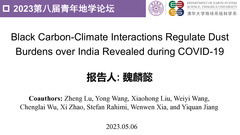报告详情
Black carbon-climate interactions regulate dust burdens over India revealed during COVID-19
编号:3511
访问权限:私有
更新:2023-04-16 15:05:51 浏览:917次
快闪报告
摘要
India as a hotspot for air pollution has heavy black carbon (BC) and dust (DU) loadings. BC has been identified to significantly impact the Indian climate. However, whether BC-climate interactions regulate Indian DU during the premonsoon season is unclear. Here, using long-term Reanalysis data, we show that Indian DU is positively correlated to northern Indian BC while negatively correlated to southern Indian BC. We further identify the mechanism of BC-dust-climate interactions revealed during COVID-19. BC reduction in northern India due to lockdown decreases solar heating in the atmosphere and increases surface albedo of the Tibetan Plateau (TP), inducing a descending atmospheric motion. Colder air from the TP together with warmer southern Indian air heated by biomass burning BC results in easterly wind anomalies, which reduces dust transport from the Middle East and Sahara and local dust emissions. The premonsoon aerosol-climate interactions delay the outbreak of the subsequent Indian summer monsoon.
关键词
black carbon,dust,climate
报告人

魏麟懿
清华大学稿件作者
全部评论
重要日期
-
会议日期
05月05日
2023
至05月08日
2023
-
03月31日 2023
初稿截稿日期
-
05月25日 2023
注册截止日期
主办单位
青年地学论坛理事会
中国科学院青年创新促进会地学分会
中国科学院青年创新促进会地学分会
承办单位
武汉大学
中国科学院精密测量科学与技术创新研究院
中国地质大学(武汉)
中国科学院精密测量科学与技术创新研究院
中国地质大学(武汉)



发表评论